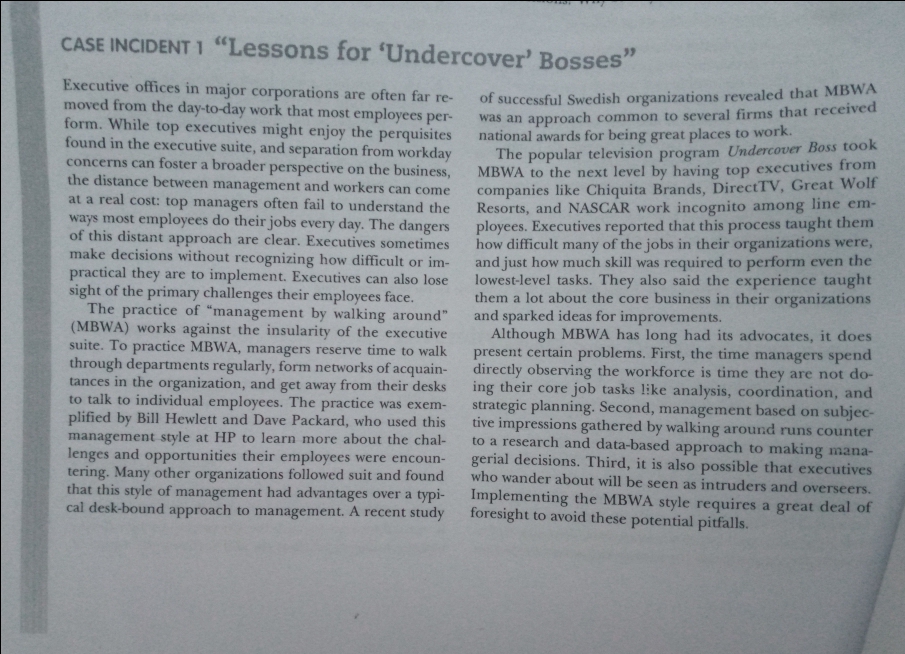Questions 1. What are some of the things managers can learn by walking around and having daily contact with line employees that they might not be able to learn from looking at data and reports?
Questions 1. What are some of the things managers can learn by walking around and having daily contact with line employees that they might not be able to learn from looking at data and reports?
Chapter1: Taking Risks And Making Profits Within The Dynamic Business Environment
Section: Chapter Questions
Problem 1CE
Related questions
Question

Transcribed Image Text:Questions
1. What are some of thc things managers can learn by
walking around and having daily contact with line
employees that they might not be able to learn from
looking at data and reports?
2. As an emplovee would vouanpre

Transcribed Image Text:CASE INCIDENT 1 "Lessons for 'Undercover' Bosses"
Executive offices in major corporations are often far re-
moved from the day-to-day work that most employees per-
form. While top executives might enjoy the perquisites
found in the executive suite, and separation from workday
concerns can foster a broader perspective on the business,
the distance between management and workers can come
at a real cost: top managers often fail to understand the
ways most employees do their jobs every day. The dangers
of this distant approach are clear. Executives sometimes
make decisions without recognizing how difficult or im-
practical they are to implement. Executives can also lose
sight of the primary challenges their employees face.
The practice of "management by walking around"
(MBWA) works against the insularity of the executive
suite. To practice MBWA, managers reserve time to walk
through departments regularly, form networks of acquain-
tances in the organization, and get away from their desks
to talk to individual employees. The practice was exem-
plified by Bill Hewlett and Dave Packard, who used this
management style at HP to learn more about the chal-
lenges and opportunities their employees were encoun-
tering. Many other organizations followed suit and found
that this style of management had advantages over a typi-
cal desk-bound approach to management. A recent study
of successful Swedish organizations revealed that MBWA
was an approach common to several firms that received
national awards for being great places to work.
The popular television program Undercover Boss took
MBWA to the next level by having top executives from
companies like Chiquita Brands, DirectTV, Great Wolf
Resorts, and NASCAR work incognito among line em-
ployees. Executives reported that this process taught them
how difficult many of the jobs in their organizations were,
and just how much skill was required to perform even the
lowest-level tasks. They also said the experience taught
them a lot about the core business in their organizations
and sparked ideas for improvements.
Although MBWA has long had its advocates, it does
present certain problems. First, the time managers spend
directly observing the workforce is time they are not do-
ing their core job tasks like analysis, coordination, and
strategic planning. Second, management based on subjec-
tive impressions gathered by walking around runs counter
to a research and data-based approach to making mana-
gerial decisions. Third, it is also possible that executives
who wander about will be seen as intruders and overseers.
Implementing the MBWA style requires a great deal of
foresight to avoid these potential pitfalls.
Expert Solution
This question has been solved!
Explore an expertly crafted, step-by-step solution for a thorough understanding of key concepts.
Step by step
Solved in 2 steps

Recommended textbooks for you

Understanding Business
Management
ISBN:
9781259929434
Author:
William Nickels
Publisher:
McGraw-Hill Education

Management (14th Edition)
Management
ISBN:
9780134527604
Author:
Stephen P. Robbins, Mary A. Coulter
Publisher:
PEARSON

Spreadsheet Modeling & Decision Analysis: A Pract…
Management
ISBN:
9781305947412
Author:
Cliff Ragsdale
Publisher:
Cengage Learning

Understanding Business
Management
ISBN:
9781259929434
Author:
William Nickels
Publisher:
McGraw-Hill Education

Management (14th Edition)
Management
ISBN:
9780134527604
Author:
Stephen P. Robbins, Mary A. Coulter
Publisher:
PEARSON

Spreadsheet Modeling & Decision Analysis: A Pract…
Management
ISBN:
9781305947412
Author:
Cliff Ragsdale
Publisher:
Cengage Learning

Management Information Systems: Managing The Digi…
Management
ISBN:
9780135191798
Author:
Kenneth C. Laudon, Jane P. Laudon
Publisher:
PEARSON

Business Essentials (12th Edition) (What's New in…
Management
ISBN:
9780134728391
Author:
Ronald J. Ebert, Ricky W. Griffin
Publisher:
PEARSON

Fundamentals of Management (10th Edition)
Management
ISBN:
9780134237473
Author:
Stephen P. Robbins, Mary A. Coulter, David A. De Cenzo
Publisher:
PEARSON